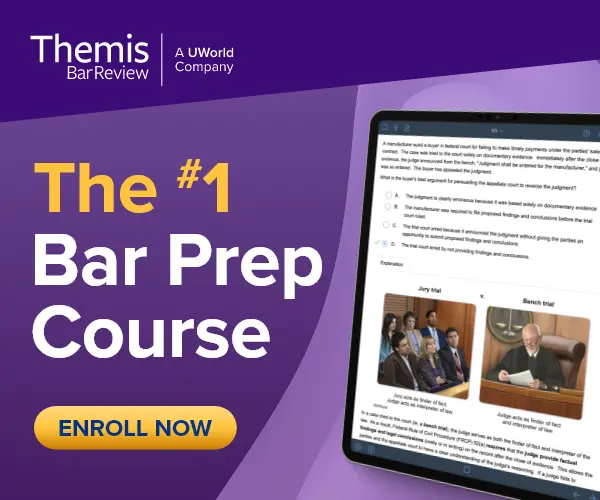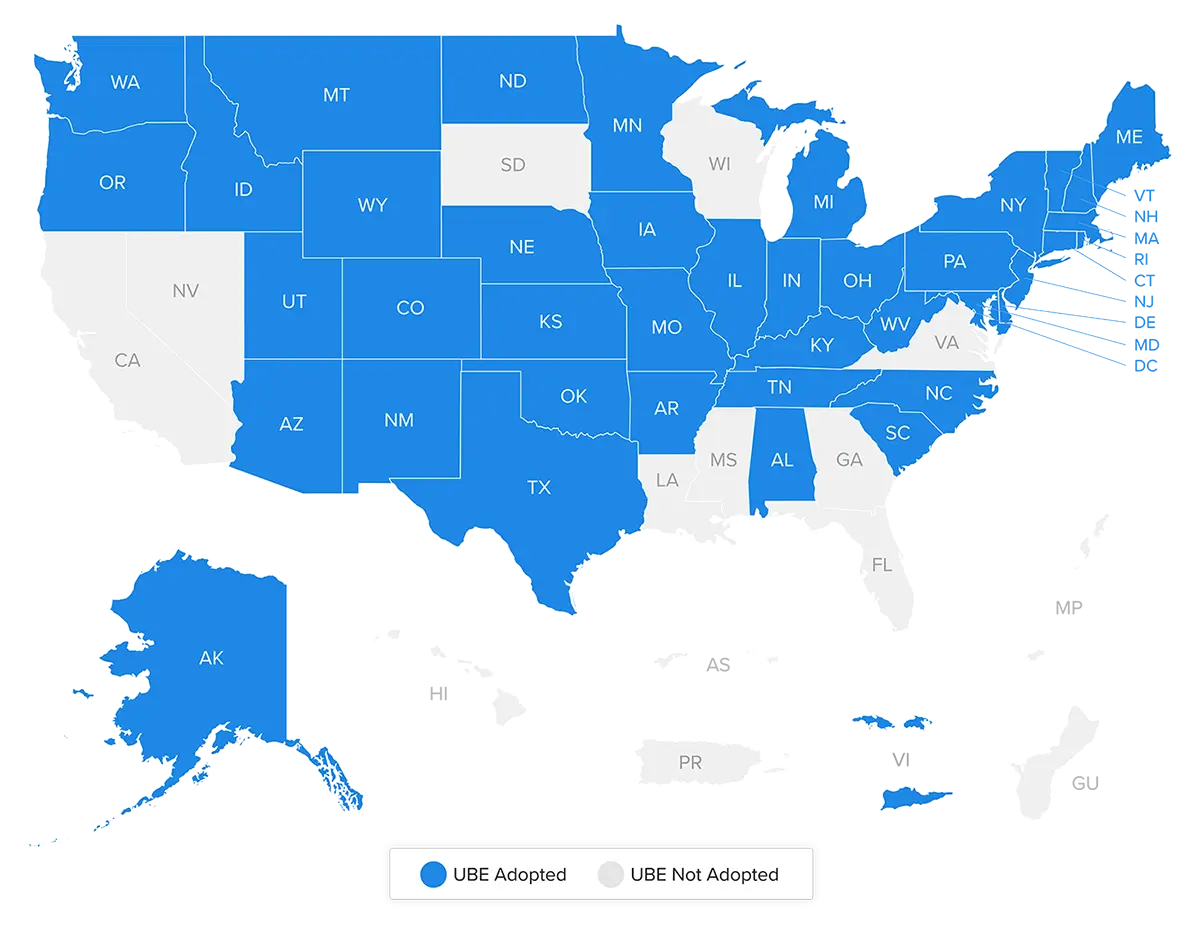The National Conference of Bar Examiners (NCBE®) developed the Uniform Bar Examination (UBE) to increase bar exam score portability between participating jurisdictions. It consists of 3 components — the Multistate Bar Examination (MBE), Multistate Essay Examination (MEE®), and the Multistate Performance Test (MPT®) — administered over 2 days. The UBE measures competence and character before empowering candidates to practice law.
All UBE jurisdictions administer the MBE, as do some nonparticipating jurisdictions. Louisiana and Puerto Rico are the only jurisdictions that do not require the MBE.
The Multistate Bar Examination: An Important Component of the UBE
The MBE assesses your ability to reason through a given fact pattern using fundamental legal principles. Each jurisdiction establishes its policy regarding the relative weight assigned to the MBE compared to other scores.
The exam is 6 hours long, divided into 2 (3-hour) sessions with 100 questions each. Only 175 of the multiple-choice questions are graded. The remaining 25 are pilot questions for future exams. MBE accounts for 50% of the total score for states that use the UBE.
As with the UBE, fees and deadlines for the MBE vary from state to state. However, every state uses the MBE to test an examinee's knowledge of the following MBE subjects:
- Civil Procedure
- Constitutional Law
- Contracts
- Criminal Law and Procedure
- Evidence
- Real Property
- Torts
Jurisdictions That Have Adopted the UBE and MBE
All UBE jurisdictions include the MBE, but not all MBE jurisdictions have adopted the UBE. The MBE is a core part of the UBE, but some states use it alongside their bar exam while rejecting the MEE and MPT.
To date, 41 jurisdictions (39 states) have adopted the UBE, while nearly every jurisdiction administers the MBE, except for Louisiana and Puerto Rico.
UBE vs. MBE: Structure, Topics, and Fees
The weightage, format, and topics of the UBE are uniform throughout participating jurisdictions. The sections below provide a blueprint for the structure of the complete UBE exam, including the MBE. Please note that each state has a unique fee schedule. Check with your state's Board of Bar Examiners, as UBE fees and deadlines can vary dramatically between jurisdictions.
| UBE Structure and Subjects | |||
|---|---|---|---|
| Component | Weightage | Format | Subjects |
| MEE | 30% | 6 (30-minute) essay questions administered over 1 (3-hour) session | Business Associations, Civil Procedure, Conflict of Laws, Constitutional Law, Contracts and Sales, Criminal Law and Procedure, Evidence, Family Law, Real Property, Torts, Trusts and Estates, Secured Transactions |
| MPT | 20% | 2 (90-minute) tasks that simulate real-world lawyering assignments | Application of Legal Reasoning (Over Pure Knowledge) |
| MBE | 50% | 200 multiple-choice questions administered over 2 (3-hour) sessions | Civil Procedure, Constitutional Law, Contracts, Criminal Law and Procedure, Evidence, Real Property, Torts |
UBE vs. MBE Score Portability
UBE scores are portable, meaning they can be transferred to participating UBE jurisdictions. However, each jurisdiction sets its own minimum UBE passing scores. To be admitted to a jurisdiction’s bar, your passing score must meet the minimum passing score established by that jurisdiction.
MBE score portability is more complex. If a jurisdiction administers the MBE but has not adopted the UBE, your ability to transfer your score depends on that jurisdiction's rules. The same applies if you took the MBE as part of the UBE and wish to transfer to a non-UBE state. Check directly with jurisdictions for details and up-to-date information, including fees, maximum scores, ages, and transfer eligibility.
The following jurisdictions accept transferred MBE scores:
| Alabama | Florida | Idaho | Canada -- FLSC |
| Kansas | Kentucky | Michigan** | Minnesota |
| Mississippi | Missouri | Northern Mariana Islands | Oklahoma* |
| Palau | South Dakota | Virgin Islands | Virginia |
| West Virginia | Wisconsin | - | - |
(*concurrent only, **reciprocal only)
Note: Check with the jurisdictions directly for details and up-to-date information, including fees, maximum scores, ages, and transfer eligibility.
UBE vs. MBE: Key Differences
The key differences between the UBE and MBE are summarized in the table below.
| UBE vs MBE: Key Differences | ||
|---|---|---|
| Details | UBE | MBE |
| Format | Consists of 3 components administered over 2 days | 200 multiple-choice questions administered over 2 (3-hour) sessions |
| Subjects | In addition to all MBE subjects: Business Associations, Civil Procedure, Conflict of Laws, Constitutional Law, Contracts and Sales, Criminal Law and Procedure, Evidence, Family Law, Real Property, Torts, Trusts and Estates, Secured Transactions | Civil Procedure, Constitutional Law, Contracts, Criminal Law and Procedure, Evidence, Real Property, Torts |
| Participating Jurisdictions | 41 | All U.S. States except Louisiana and Puerto Rico |
| Score Portability | Yes, to other UBE jurisdictions, depending on the admission criteria | MBE scores can be transferred to other states via MBE Score Services |





